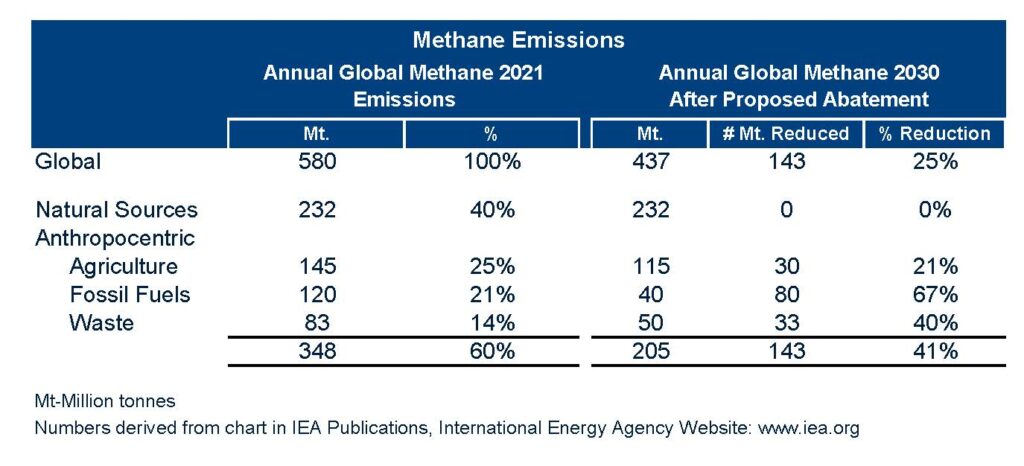
Dec 26, 2023 Methane and Climate Change
Methane is the smallest hydrocarbon – a chemical compound containing only carbon and hydrogen molecules – and has the chemical formula CH4. It is the main component (70-90%) of natural gas, and when burned, one molecule of methane produces one molecule of carbon dioxide and two molecules of water. Methane has much greater warming potential than carbon dioxide and is responsible for approximately 30% of global warming. Methane emissions are projected to continue to rise by up to 13% between 2020 and 2030.
Unlike carbon dioxide, methane has a short half-life (12 rather than hundreds of years) in the atmosphere. Therefore, limiting new methane emissions will have a relatively rapid impact on global warming. According to the International Energy Agency, the world is currently emitting around 580 million tonnes of methane into the atmosphere every year. Of the 580 million tonnes, 384 (60%) are anthropogenic emissions (human activity), and 196 million tonnes (40%) are from natural sources. The anthropocentric emissions could be reduced using existing technology. More than 143 million tonnes of methane emissions from anthropocentric sources could be eliminated by 2030 using existing technology at low or even negative costs.

During COP28, the US EPA announced a final methane rule for US oil and gas producers, requiring them to plug methane leaks and stop burning excess gas. In addition, US Special Presidential Envoy for Climate, John Kerry, announced the establishment of a $1 billion grant fund to assist lower-income nations to tighten methane emissions from their oil and gas operations during COP28. The US will also work directly with Kazakhstan, considered a methane “super-emitter” by the International Energy Agency, to curb leaks and methane venting by 2030. New satellite imagery can now visualize methane leaks into the atmosphere. This new tool is expected to lead to much quicker enforcement of methane leaks in the USA.
China has so far been a wild card in efforts to control methane emissions. It is the largest emitter of methane in the world. Until COP28 in Dubai, China had refused to join the US-led Global Methane Pledge, in which 156 other countries participated. China has now indicated it will add methane to its 2035 climate action plan, and US and Chinese officials hosted a “methane summit” in Dubai. An Oil & Gas Decarbonization Charter was launched at COP28, in which 50% of oil and gas companies accounting for 40% of global oil and gas production committed to implementing significant cuts in their methane emissions.
Atmospheric methane also affects human health through complicated chemical reactions involving heat and water vapor that increase ground-level ozone. One model indicates that eliminating the emission of methane into the atmosphere could reduce global warming by 1oC and also avoid 690,000 premature human deaths by 2050.
Practical approaches that reduce methane release from fossil fuel production and agriculture would be very beneficial for the planet, for biodiversity, and for the health of human individuals. Fortunately, techniques to reduce methane are already available, and some can be implemented at a negative cost.


